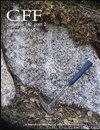Solstad, a Co-Se-bearing copper ore in the Västervik quartzites, Sweden
IF 1.2
4区 地球科学
Q2 GEOLOGY
引用次数: 0
Abstract
ABSTRACT The Solstad copper deposit, located in SE Sweden, is hosted by a quartz-rich rock sliver surrounded by a granite belonging to the 1.8 Ga Transscandinavian Igneous Belt. Ore petrographic studies have revealed a number of previously unrecognized opaque phases, including several Co phases, selenides and tellurides. Based on an in situ U-Pb investigation of zircons from a mineralized sample, it is suggested that zircons have a detrital origin and that the quartz-rich host rock is a xenolith belonging to the c. 1.88–1.86 Ga Västervik quartzite formation. A low-radiogenic galena sample implies that the source for the metals in the ore has a primitive origin, probably the basaltic lavas (now amphibolites) that are intercalated in the Västervik quartzite. Fluid inclusion studies in quartz distinguish four distinct ore fluids: (1) a hypersaline halite-bearing aqueous fluid related to an early (1.85–1.86 Ga) chalcopyrite depositional stage, (2) a subsequent CO2-rich fluid, that deposited native gold, tellurides, selenides and bismuthinite, developed (at ≥1.8 Ga) as a result of a phase separation, (3), a moderate- to high-salinity aqueous fluid did also develop at this event and led to the deposition of bornite and (4) a concluding, low-salinity aqueous fluid stage (at ≤1.8 Ga) caused oxidation to covelline and digenite of previously formed phases. It is proposed that the Solstad deposit and other Cu ± Co-rich sulphide (± magnetite) occurrences in the Västervik region along the southernmost margin of the 1.9–1.8 Ga Svecofennian Domain, represent a distinct ore type associated with quartzites and amphibolites.瑞典Västervik石英岩中的一种含钴硒铜矿石
本文章由计算机程序翻译,如有差异,请以英文原文为准。
求助全文
约1分钟内获得全文
求助全文
来源期刊

Gff
地学-地质学
CiteScore
2.80
自引率
10.00%
发文量
11
审稿时长
>12 weeks
期刊介绍:
GFF is the journal of the Geological Society of Sweden. It is an international scientific journal that publishes papers in English covering the whole field of geology and palaeontology, i.e. petrology, mineralogy, stratigraphy, systematic palaeontology, palaeogeography, historical geology and Quaternary geology. Systematic descriptions of fossils, minerals and rocks are an important part of GFF''s publishing record. Papers on regional or local geology should deal with Balto-Scandian or Northern European geology, or with geologically related areas. Papers on geophysics, geochemistry, biogeochemistry, climatology and hydrology should have a geological context. Descriptions of new methods (analytical, instrumental or numerical), should be relevant to the broad scope of the journal. Review articles are welcome, and may be solicited occasionally. Thematic issues are also possible.
 求助内容:
求助内容: 应助结果提醒方式:
应助结果提醒方式:


